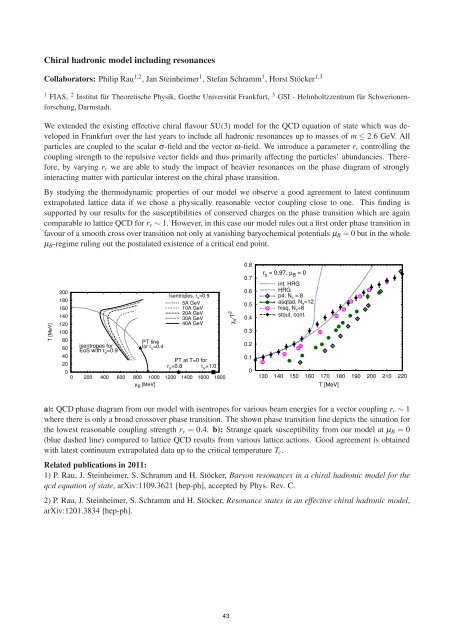FIAS Scientific Report 2011 - Frankfurt Institute for Advanced Studies ...
FIAS Scientific Report 2011 - Frankfurt Institute for Advanced Studies ...
FIAS Scientific Report 2011 - Frankfurt Institute for Advanced Studies ...
You also want an ePaper? Increase the reach of your titles
YUMPU automatically turns print PDFs into web optimized ePapers that Google loves.
Chiral hadronic model including resonances<br />
Collaborators: Philip Rau 1,2 , Jan Steinheimer 1 , Stefan Schramm 1 , Horst Stöcker 1,3<br />
1 <strong>FIAS</strong>, 2 Institut für Theoretische Physik, Goethe Universität <strong>Frankfurt</strong>, 3 GSI - Helmholtzzentrum für Schwerionen-<br />
<strong>for</strong>schung, Darmstadt.<br />
We extended the existing effective chiral flavour SU(3) model <strong>for</strong> the QCD equation of state which was developed<br />
in <strong>Frankfurt</strong> over the last years to include all hadronic resonances up to masses of m ≤ 2.6 GeV. All<br />
particles are coupled to the scalar σ-field and the vector ω-field. We introduce a parameter rv controlling the<br />
coupling strength to the repulsive vector fields and thus primarily affecting the particles’ abundancies. There<strong>for</strong>e,<br />
by varying rv we are able to study the impact of heavier resonances on the phase diagram of strongly<br />
interacting matter with particular interest on the chiral phase transition.<br />
By studying the thermodynamic properties of our model we observe a good agreement to latest continuum<br />
extrapolated lattice data if we chose a physically reasonable vector coupling close to one. This finding is<br />
supported by our results <strong>for</strong> the susceptibilities of conserved charges on the phase transition which are again<br />
comparable to lattice QCD <strong>for</strong> rv ∼ 1. However, in this case our model rules out a first order phase transition in<br />
favour of a smooth cross over transition not only at vanishing baryochemical potentials µB = 0 but in the whole<br />
µB-regime ruling out the postulated existence of a critical end point.<br />
T [MeV]<br />
200<br />
180<br />
160<br />
140<br />
120<br />
100<br />
isentropes, r v =0.9<br />
5A GeV<br />
10A GeV<br />
20A GeV<br />
30A GeV<br />
40A GeV<br />
80<br />
60<br />
40<br />
20<br />
0<br />
0<br />
isentropes <strong>for</strong><br />
EoS with rv =0.9<br />
200 400 600<br />
PT line<br />
<strong>for</strong> rv =0.4<br />
PT at T=0 <strong>for</strong><br />
rv =0.8 rv =1.0<br />
800 1000 1200 1400 1600 1800<br />
µ B [MeV]<br />
χ s /T 2<br />
0.8<br />
0.7<br />
0.6<br />
0.5<br />
0.4<br />
0.3<br />
0.2<br />
0.1<br />
0<br />
r s = 0.97, µ B = 0<br />
int. HRG<br />
HRG<br />
p4, N τ = 8<br />
asqtad, N τ =12<br />
hisq, N τ =8<br />
stout, cont.<br />
130 140 150 160 170 180 190 200 210 220<br />
T [MeV]<br />
a): QCD phase diagram from our model with isentropes <strong>for</strong> various beam energies <strong>for</strong> a vector coupling rv ∼ 1<br />
where there is only a broad crossover phase transition. The shown phase transition line depicts the situation <strong>for</strong><br />
the lowest reasonable coupling strength rv = 0.4. b): Strange quark susceptibility from our model at µB = 0<br />
(blue dashed line) compared to lattice QCD results from various lattice actions. Good agreement is obtained<br />
with latest continuum extrapolated data up to the critical temperature Tc.<br />
Related publications in <strong>2011</strong>:<br />
1) P. Rau, J. Steinheimer, S. Schramm and H. Stöcker, Baryon resonances in a chiral hadronic model <strong>for</strong> the<br />
qcd equation of state, arXiv:1109.3621 [hep-ph], accepted by Phys. Rev. C.<br />
2) P. Rau, J. Steinheimer, S. Schramm and H. Stöcker, Resonance states in an effective chiral hadronic model,<br />
arXiv:1201.3834 [hep-ph].<br />
43
















